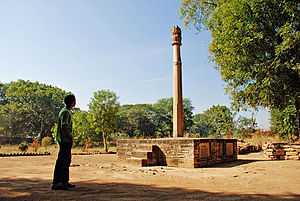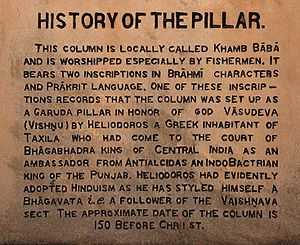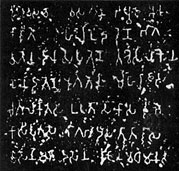Heliodorus pillar
The Heliodorus pillar is a stone column that was erected around 113 BCE in central India[1] in Vidisha near modern Besnagar, by Heliodorus, a Greek ambassador of the Indo-Greek king Antialcidas to the court of the Sunga king Bhagabhadra. The site is located only 5 miles from the Buddhist stupa of Sanchi.
The pillar was surmounted by a sculpture of Garuda and was apparently dedicated by Heliodorus to the god Vāsudeva in front of the temple of Vāsudeva.

Inscriptions
There are two inscriptions on the pillar.

The first inscription describes in Brahmi the situation of Heliodorus and his relationship to the Sunga and Indo-Greek kings.
"Devadevasa Va [sude]vasa Garudadhvajo ayam
karito i[a] Heliodorena bhaga-
vatena Diyasa putrena Takhasilakena
Yonadatena agatena maharajasa
Amtalikitasa upa[m]ta samkasam-rano
Kasiput[r]asa [Bh]agabhadrasa tratarasa
vasena [chatu]dasena rajena vadhamanasa"— Original inscription
- "This Garuda-standard of Vāsudeva, the God of Gods
 The first inscription of the Heliodorus pillar that was made by Heliodorus 110 BCE.
The first inscription of the Heliodorus pillar that was made by Heliodorus 110 BCE. - was erected here by the devotee Heliodoros,
- the son of Dion, a man of Taxila,
- sent by the Great Greek (Yona) King
- Antialkidas, as ambassador to
- King Kasiputra Bhagabhadra, the Savior
- son of the princess from Benares, in the fourteenth year of his reign."
- (Archaeological Survey of India, Annual Report (1908-1909))
Although not perfectly clear, the inscription seems to be referring to Heliodoros as a Bhagavata (Sanskrit: “One Devoted to Bhagavan (Lord)”), meaning "a devotee". In the context of Hinduism, a Bhagavat would be a member of the earliest recorded Hindu faith devoted to Vishnu.
The second inscription on the pillar describes in more detail the spiritual content of the faith supported by Heliodorus:
"Trini amutapadani‹[su] anuthitani
nayamti svaga damo chago apramado"— Original inscription
- "Three immortal precepts (footsteps)... when practiced
- lead to heaven: self-restraint, charity, consciousness"
- (Archaeological Survey of India, Annual Report (1908-1909))
Context
The pillar was surmounted by a sculpture of the eagle Garuda and was apparently dedicated by Heliodorus to Vāsudeva, called god of gods, in front of the temple of Vasudeva. He, along with Agathocles of the same period, would be one of the earliest recorded converts to the Vaishnava tradition of Hinduism.
Coins minted during the time period of Antialcidas depict Dios Krishna with lotus-tipped sceptre, in front of an elephant with a bell (symbol of Taxila), surmouted by Nike holding a wreath, crowning the elephant. The coins carry the inscription "BASILEOS NIKEPHOROU ANTIALKIDOU". These coins were also minted at the Pushkalavati mint and carry the same inscription in Kharoṣṭhī script [2]
Zeus' Eagle messenger and companion Aetos Dios,[3] was considered as Zeus himself.
"When you [Zeus] were an eagle, when you picked up the boy [Ganymede] on the slopes of Teukrian Ida with greedy gentle claw, and brought him to heaven." - Nonnus, Dionysiaca 10. 308 ff
Aetos Dios was also considered a "messenger of God (Zeus)" and adopted by the Greek and Roman military:
"he put a golden eagle on his war standards and dedicated it as a protection for his valour" - Anacreon, Fragment 505d (from Fulgentius, Mythologies) (trans. Campbell, Vol. Greek Lyric II) (Greek lyric 6th century BC)
Professor Kunja Govinda Goswami of Calcutta University concludes that Heliodorus "was well acquainted with the texts dealing with the Bhagavata religion."[4]
Based on this evidence it has been suggested that Heliodorus is one of the earliest Westerner on record to convert to Vaishnavism whose evidence has survived . But some scholars, most notably A. L. Basham[5] and Thomas Hopkins, are of the opinion that Heliodorus was not the earliest Greek to convert to Bhagavata Krishnaism. Hopkins, chairman of the department of religious studies at Franklin and Marshall College, has said, "Heliodorus was presumably not the earliest Greek who was converted to Vaishnava devotional practices although he might have been the one to erect a column that is still extant. Certainly there were numerous others including the king who sent him as an ambassador."[6]
See also
References
- ↑ http://www.youtube.com/watch?v=L71FAhl7Yfo&feature=player_embedded
- ↑ Antialcidas - http://en.wikipedia.org/wiki/Antialcidas
- ↑ Aetos Dios
- ↑ K. G. Goswami, A Study of Vaisnavism (Calcutta: Oriental Book Agency, 1956), p. 6
- ↑ A. L. Basham, The Wonder That Was India, 3rd ed. (Oxford: Taplinger Pub. Co., 1967), p. 60.
- ↑ Steven J. Gelberg, ed.. Hare Krsna Hare Krsna (New York: Grove Press, Inc., 1983), p. 117
External links
| Wikimedia Commons has media related to Heliodorus Pillar, Vidishā, Madhya Pradesh, India. |